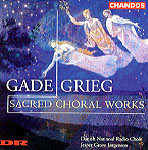This is an excellent disc, one that choral music lovers will want to snap up, and one whose program leaves you wondering why this music is so rarely (if ever) heard and recorded. Anyone who enjoys German Romantic and post-Romantic English religious choral music will be right at home here–but you may be surprised at the adeptness and facility of the writing from two composers never cited for their choir works. It goes way beyond mere competence: many of these pieces, especially the ones by Grieg, could stand alongside much of the a cappella repertoire of Brahms and way above those oft-performed Bruckner motets in their harmonic invention, and certainly are as charming and affecting as most anything those celebrated English composers of the late-19th/early 20th centuries produced. Not that there isn’t some syrupy or formulaic or just plain ordinary stuff in here, too–but who among the composers referred to above isn’t also guilty of that? However, when you hear the last of Grieg’s Four Hymns Op. 74, you’ll not only be struck by the beauty of the tune (it comes from a famous collection of Norwegian folk ballads) but also by the sophistication of Grieg’s treatment of the choir, which plays a role at once supportive and independent. The Two Religious Choruses, eight-part a cappella choral settings of original songs the composer originally wrote for voice and piano, are sublime, little masterpieces deserving a place in the standard repertoire. The fugal Dona nobis pacem, a very early Grieg work, is guilty of the cumbersome, academic style of a student work (Grieg was in his final year of conservatory in Leipzig), but after all that comes before on this program, you easily can forgive this effort.
The Gade pieces include four church-style hymns, the last of which is the beguiling “Baby Jesus in a crib He lay”, an arrangement of an earlier Christmas song for voice and piano with text by Hans Christian Andersen. We also hear a sturdy if somewhat predictable bit of harmonic writing in the Benedictus and Amen (with organ accompaniment). But the heart of the Danish composer’s contributions is found in the Three sacred choruses, ravishing in their Mendelssohnian emotional character, attractive melodies, and rich harmonies.
Baritone soloist Per Høyer is marvelous, his rich, sweet, lyric tone used to maximum effect in the hymn “I Himmelen, i Himmelen”. The choir, too is first rate. This world-class ensemble’s warm, full, ideally balanced sound–and heavenly sopranos and altos–is perfect for this music. Intonation is not flawless, but nearly so–it wavers in only a small handful of instances, and these are difficult passages for the upper voices. Sound is just about perfect, with only a little harshness in the loudest moments of full-ensemble singing.
































